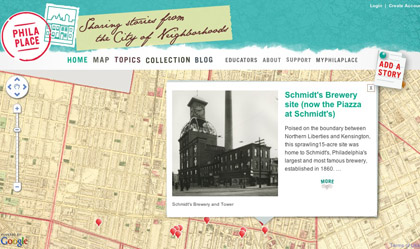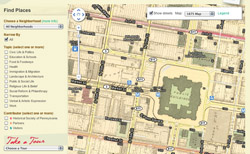
The Keystone Sewing Machine company, based at Second and Poplar in Northern Liberties, is located in a building that was once a dance hall built in the late 1800s.
Frankford Avenue’s Bike Stable was built in 1890 to house horses, once sharing a wall with a Kensington police station on neighboring Front St., before Kensington was a part of the city.
These stories, along with more than 150 others, are being shared with accompaniments of video, audio, images and scans of historical documents at PhilaPlace, a new site designed by the Historical Society of Pennsylvania, a three-year project that launched last week.
“[We focus on] neighborhoods ‘beyond the bell,’ beyond the revolutionary history. The history of neighborhoods of people who built this city, who make Philadelphia, Philadelphia,” project coordinator Melissa Mandell says.
PhilaPlace had very different beginnings, after a modest grant from Pew’s Heriage Philadelphia program helped the Historical Society package together two trolley tours in South Philadelphia and Northern Liberties.
It was a mandate to talk about 19th century ethnic and immigrant working-class history, Mandell says. “Not being in the trolley tour business,” HSP decided on focusing on a virtual environment as it moved forward.
And the project got bigger�much so.
The breadth of this online effort is a “huge undertaking,” and a first for the Historical Society. HSP worked with the Philadelphia Department of Records and PennDesign, along with dozens of partners, endowed by $500,000 in grants from National Endowment for the Humanities, Institute of Museum and Library Services, Pew’s Heritage Philadelphia Program and others.
Mandell says the site currently houses thousands of images, 40 to 50 videos and audio to support 150 stories collected by the various partners involved.
Now it’s your turn. Organizers are looking to user submissions to see the site’s content build. “This is the fun part, when we really have to get to work,” Mandall says.
THE TECHNOLOGY

PhilaPlace’s slick design is a product of Night Kitchen Interactive, a design firm which has won awards for its work with the Smithsonian, National Constitution Center, Academy of Natural Sciences and the Philadelphia Museum of Art. Night Kitchen also designed Rosenbach Museum’s Abe Lincoln iPhone app, which we’ve covered in the past.
The site uses a collections management system�often used for cataloging museum collections�developed by Whirl-i-gig.
Perhaps the heart of the project is PhilaPlace’s innovative and interactive maps. Using four different historical map overlays plugged into the Google Maps API, all the stories on the site that can be geo-referenced, or sorted by topic, are browsable in a Google Map that uses real scans of antique maps, like a yellowed copy of a map from 1875. More advanced maps, complete with historical census overlays, are planned.
Users can browse already-assembled tours�ones created in the original trolley grant�or they can create their own after signing up for the site. After logging in, users can add new sites and stories, save favorites, and more.
“As we grow, one of the things we ask is ‘where do we go next,'” Mandall says.
HSP hopes to invite new partners to submit content that is already available in archives like the Penn School of Design and the Philadelphia Department of Records.
“It’ll be a shared authority. It took us three years because we wanted to do depth rather then breadth. [We went] deep in South Philly and Northern Liberties instead of wide across the city. Who we partner with, maybe we [will] get a lot of stories about [other] particular areas.”
And of course, they’re looking to users to share their Philadelphia stories.
“Part of the reason we got the grant is because it’s an experiment of ethnology in a digital environment. We’re not afraid to be wrong, we’re not afraid to be challenged.”
Every Monday, Technically Not Tech will feature people, projects, and businesses that are involved with Philly�s tech scene, but aren�t necessarily technology focused. See others here.







